Can You Repair A Roof Leak From Inside
1 / 12
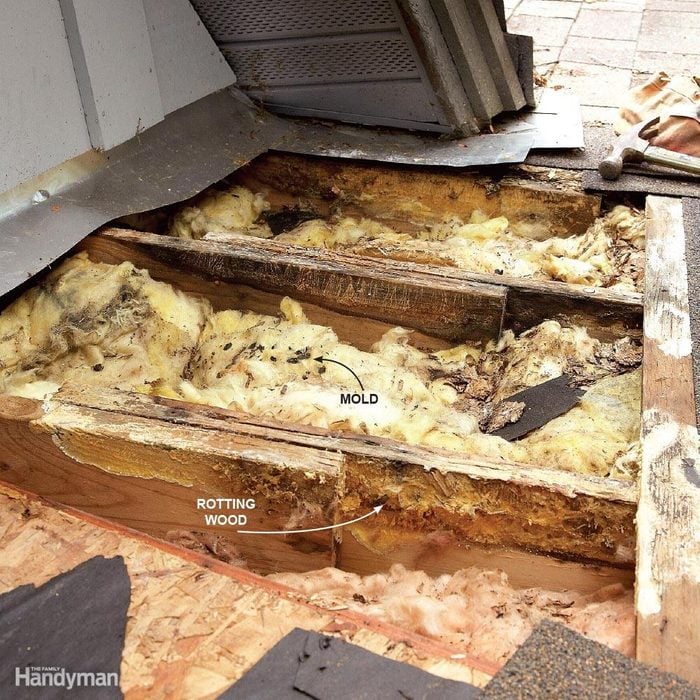
Leaky Roof Overview
If you accept water stains that extend across ceilings or run down walls, the cause is probably a leaky roof. Tracking downward the leak is the hard part; the roof leak repair is commonly pretty easy. Nosotros'll evidence yous some uncomplicated tricks for finding and repairing nearly of the mutual types of leaky roofs. But if y'all live in the Snowfall Belt and in the winter you have leaks merely on warm or sunny days, you probably accept ice dams. We won't become into that roof leak repair in this story. Check out this article for more on preventing ice dams. If you accept a leaky roof, you'd better fix information technology immediately, fifty-fifty if it doesn't bother you lot much or yous're getting a new roof adjacent year. Even over a short time, modest leaks tin can lead to big problems, such as mold, rotted framing and sheathing, destroyed insulation and damaged ceilings. The flashing leak that caused an expensive repair bill was obvious from the ceiling stains for over ii years. If the homeowner had dealt with it right abroad, the damage and subsequent repairs would accept been minimal.
2 / 12
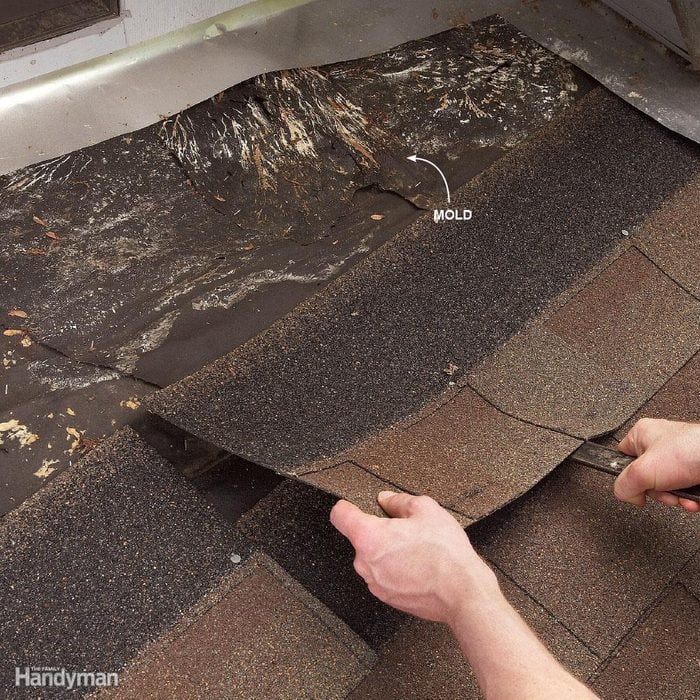
How to Find Roof Leaks
When yous're trying to track downward a leak, start by looking at the roof uphill from the stains. The first thing to look for is any roof penetrations. Items that penetrate the roof are by far the most common source of leaks. In fact, it's rare for leaks to develop in open areas of uninterrupted shingles, even on older roofs. Penetrations can include plumbing and roof vents, chimneys, dormers or anything else that projects through the roof. They can exist several feet higher up the leak or to the correct or left of it. If you accept cranium admission, the easiest manner to track down a leak is to go up in that location with a flashlight and look for the testify. At that place will be water stains, blackness marks or mold. But if access is a problem or you have a vaulted ceiling, you'll have to go upward onto the roof and examine the suspect(s).
3 / 12
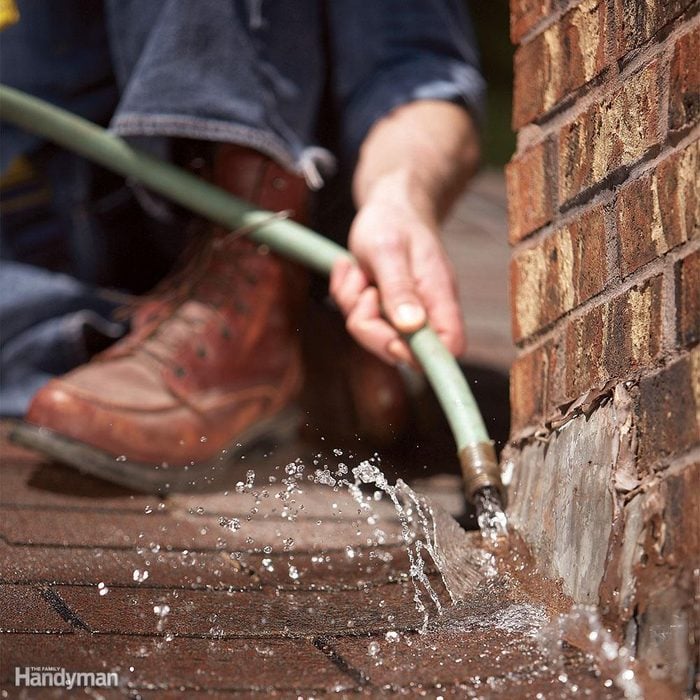
A Fob for Finding Difficult Leaks
If a leak is difficult to detect, enlist a helper and become up on the roof with a garden hose. Beginning low, soaking the area just in a higher place where the leak appears in the house. Isolate areas when you run the hose. For example, soak the downhill side of a chimney showtime, so each side, then the top on both sides. Have your helper stay inside the house waiting for the drip to announced. Allow the hose run for several minutes in one area earlier moving it upwards the roof a petty further. Tell your helper to yell when a baste becomes visible. You'll be in the neighborhood of the leak. This procedure can take well over an hour, and then be patient and don't move the hose too soon. Purchase your helper dinner. If running water doesn't reveal the verbal location of the leak, don't exist timid. Start removing shingles in the suspect surface area. With them removed, at that place'll be evidence of the leak and you'll be able to track it down right to the source. You'll see discolored felt paper or water-stained or even rotted forest direct below and around a leaky roof.
4 / 12
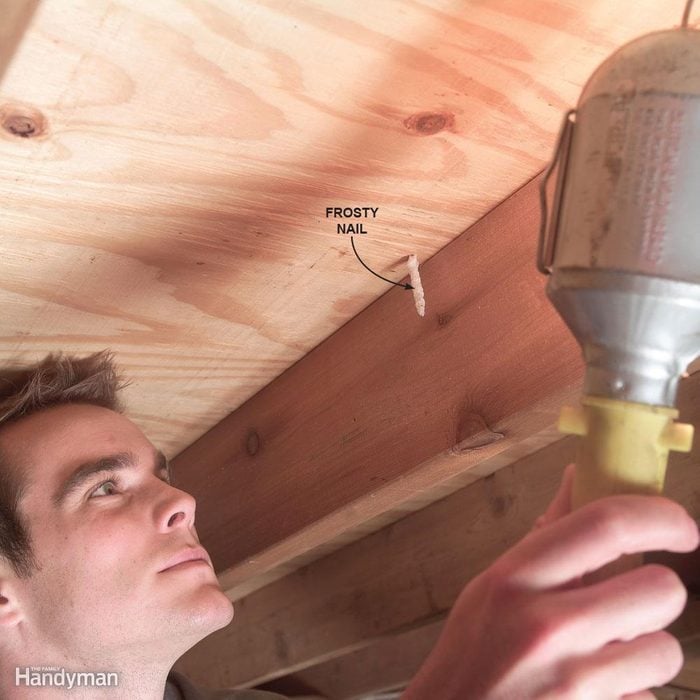
Solution for a Minor Leak
Some roof leaks are tough to locate. Sometimes the water shows upwardly at a ceiling spot distant from the leak. If your ceiling has a plastic vapor barrier between the drywall and the attic insulation, button the insulation aside and await for flow stains on the plastic. Often h2o runs to openings in the vapor barrier, such as at ceiling light fixtures.
If you can't run into whatever telltale flow marks, and since the stain is fairly small, look at the underside of the roof for 'shiners.' A shiner is a blast that missed the framing member, in this case when the carpenter nailed the roof sheathing to the rafters. Moisture that escapes into the cold attic from the rooms below oft condenses on cold nails. Sometimes y'all can spot this if you climb up into your attic on a cold night. The nails will await white because they're frosted. When the attic heats upwardly a bit during the day, the frost melts and drips, then the nails frost upwardly at nighttime once again and and so on. The solution is to just clip the nail with a side-cut pliers.
5 / 12

Fix Plumbing Vent Boots
Plumbing vent boots can exist all plastic, plastic and metallic, or even two-slice metal units. Check plastic bases for cracks and metallic bases for broken seams. Then examine the rubber boot surrounding the piping. That tin exist rotted away or torn, assuasive water to work its mode into the house forth the pipe. With whatever of these bug, you should buy a new vent kick to supercede the erstwhile one. But if the nails at the base are missing or pulled free and the boot is in good shape, replace them with the rubber-washered screws used for metal roofing systems. Y'all'll discover them at whatsoever dwelling house eye with the rest of the screws. You'll accept to work neighboring shingles free on both sides. If you don't accept extra shingles, be conscientious when y'all remove shingles so they tin be reused. Use a flat bar to dissever the sealant between the layers. Then yous'll be able to drive the flat bar under the boom heads to pop out the nails.
6 / 12
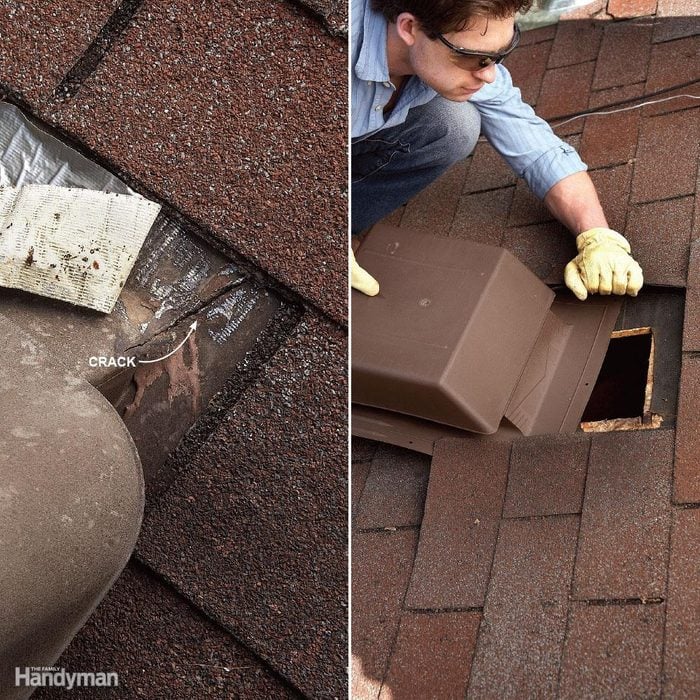
How to Fix Roof Vents
Check for croaky housings on plastic roof vents and broken seams on metal ones. You might be tempted to throw caulk at the problem, but that solution won't last long. There'due south really no fix other than replacing the damaged vents. Also look for pulled or missing nails at the base's bottom edge. Supercede them with rubber-washered screws. In most cases, you tin remove nails under the shingles on both sides of the vent to pull information technology free. There will exist nails across the superlative of the vent as well. Usually you can also work those loose without removing shingles. Screw the bottom in place with prophylactic-washered screws. Clasp out a dewdrop of caulk beneath the shingles on both sides of the vent to concur the shingles downward and to add together a water barrier. That's much easier than renailing the shingles.
vii / 12

Set Walls and Dormers
H2o doesn't always come in at the shingled surface. Oft, wind-driven pelting comes in from above the roof, peculiarly around windows, betwixt corner boards and siding, and through cracks and knotholes in siding. Dormer walls provide lots of spots where h2o tin dribble down and enter the roof. Caulk tin can be old, cracked or even missing betwixt the corner boards and between window edges and siding. Water penetrates these cracks and works its way behind the flashing and into the business firm. Fifty-fifty caulk that looks intact may not be sealing confronting the adjoining surfaces. Dig around with a putty knife to see if the area is sealed. Dig out any suspect caulk and replace information technology with a high-quality caulk. Also check the siding to a higher place the footstep flashing. Supercede any cracked, rotted or missing siding, making certain the new piece overlaps the pace flashing past at to the lowest degree two in. If you still have a leak, pull the corner boards complimentary and bank check the overlapping flashing at the corner. Often, at that place's sometime, hardened caulk where the two pieces overlap at the inside corner.
8 / 12

Complex Roof Problem
This roof leaks during the snowy role of winter and during storms in the summer, certainly due to poor flashing. The soffit that meets the roof is one of the toughest areas to waterproof. In the photo, you lot can still see signs of an ice dam. An ice dam occurs when snow melts and the water freezes when it hits the colder edges of your roof. Eventually, h2o pools backside the dam and works its way support under the shingles and under the soffit until it finds an opening through the roof. The solution begins with good flashing since this should stop leaks from rainfall and might terminate the leaks from ice dams every bit well. Brainstorm by removing the shingles downwards to the wood sheathing and slip a strip of adhesive water ice-and-h2o barrier (bachelor where roofing repair products are sold) under the soffit/main roof joint. Depending on how the roofs join, you may have to cut a slot to work information technology in far enough. It should overlap another piece of ice-and-water barrier laid below, all the way downwards to the roof edge. This should cover the nearly leak-prone areas. Then reshingle, sliding metal step flashing behind the fascia board (the trim behind the gutter). The valley flashing, laid over the joint where the two roofs run into, should overlap the step flashing at least 2 in. If leaks go along to occur from water ice dams, consider installing roof border heating cables. (Find them locally at hardware stores or home centers.) Improved attic insulation and ventilation are ordinarily the best ways to prevent ice dams, but they might non exist effective in this complicated leaky roof situation.
ix / 12
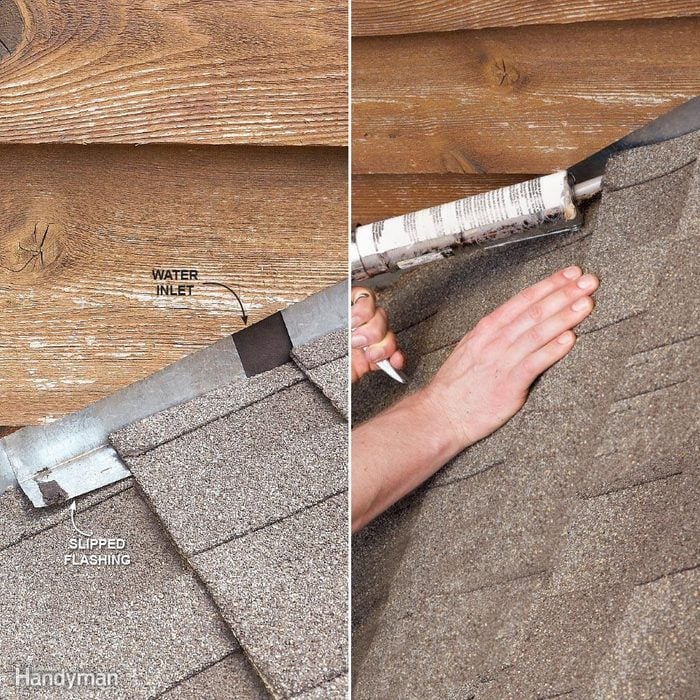
Gear up Pace Flashing
Step flashing is used along walls that intersect the roof. Each short section of flashing channels h2o over the shingle downhill from it. But if the flashing rusts through, or a piece comes loose, h2o will run correct backside it, and into the house it goes. Rusted flashing needs to exist replaced. That means removing shingles, prying siding loose, and then removing and replacing the step flashing. It'due south that unproblematic. But occasionally a roofer forgets to nail i in place and it eventually slips downward to expose the wall. Check out this article for more on installing your own pace flashing.
10 / 12

Don't Count on Caulk!
Rarely volition caulk or roof cement cure a leaky roof —at least for very long. You should always attempt a "mechanical" leaky roof prepare whenever possible. That means replacing or repairing existing flashing instead of using whatever type of sealant as a leak stopper. Only use caulk for very small holes and when flashing isn't an choice every bit a leak stopper.
eleven / 12
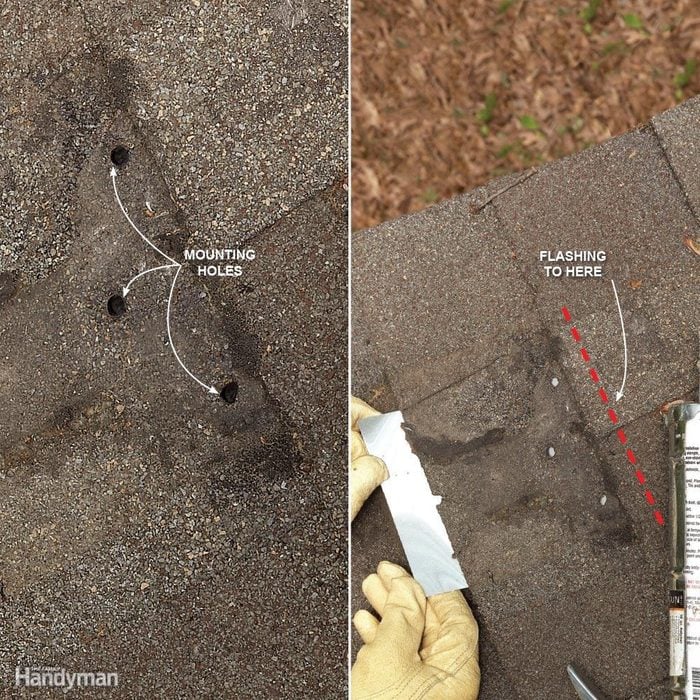
Set up Pocket-size Holes
Tiny holes in shingles are sneaky considering they can crusade rot, a leaky roof and other damage for years before you lot notice the obvious signs of a leak. You might observe holes left over from a satellite dish or antenna mounting brackets or just virtually annihilation. And exposed, misplaced roofing repair nails should be pulled and the holes patched. Pocket-sized holes are elementary to fix, but the gear up isn't to inject caulk in the hole. Yous'll fix this leaky roof problem with flashing.
12 / 12

Leaks Around Brick Chimneys
All kinds of bad things can happen effectually brick chimneys. In fact, there are far too many to cover in this story. Flashing around chimneys tin can rust through if it's galvanized steel, specially at the 90-degree bend at the bottom. A quick but fairly long-term set is to simply slip new flashing nether the old rusted stuff. That way any water that seeps through volition be diverted. The best fix, though, is to cutting a saw kerf into the mortar and install new flashing. Get complete instructions on how to install chimney flashing.
If you're in search of a good ladder to get y'all upward on the roof, bank check out this video from Stuff We Beloved on the Little Behemothic 22-foot ladder, which is available on Amazon.
Originally Published: July xviii, 2022
Source: https://www.familyhandyman.com/list/roof-repair-how-to-find-and-fix-roof-leaks/
Posted by: janssonsoublartand1963.blogspot.com


0 Response to "Can You Repair A Roof Leak From Inside"
Post a Comment